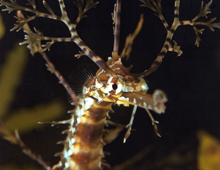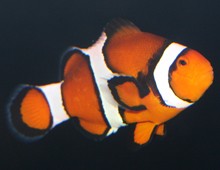New Guinea

Ribboned seadragon, Haliichthys taeniophorus
The Ribbon seadragon, more accurately described as a pipehorse, is a close relative of the seahorses and pipefish. Depicted as the “Rainbow serpent” in the Aboriginal rock art of Arnhem Land, the Ribbon seadragon was believed to have special powers. In 2006, The DWA became the first aquarium in the world to successfully breed this relatively unknown species. Like other Syngnathids, the Ribbon seadragon feeds on very small shrimp known as mysid shrimp. Unlike their cousins the Leafy (Phycodurus eques) and Weedy seadragons (Phyllopteryx taeniolatus), the male Ribbon seadragon possesses a pouch and can give birth to more than 800 fully developed offspring at a time.
LEARN MORE
Mandarin dragonet, Synchiropus splendidus
The Mandarin dragonet is sometimes called the Psychedelic fish because of its flamboyant coloration which resembles the robe of an Imperial Chinese officer. It is an extremely popular aquarium fish known for its intricate mating displays. Mandarin dragonets feed on small crustaceans found in the sediment and crevices of rock and corals. Their natural range includes the Western Pacific, Indonesia the Philippines and Australia.
LEARN MORE
Striped shrimpfish, Aeoliscus strigatus
The Striped shrimpfish, or Razorfish, is an unusual fish that is a distant relative of the seahorses and pipefish. Its slender, flattened body allows it to hide amongst the branches of corals or spines of a sea urchin. It swims “upside down” in synchronized schools and feeds on tiny zooplankton. The Striped shrimpfish inhabits shallow coral reefs throughout the Indo-West Pacific.
LEARN MORE
Copperband butterflyfish, Chelmon rostratus
The Copperband or Beaked butterfly fish is a popular species, but can be a finicky aquarium inhabitant. By nature, the Copperband butterfly feeds on coral polyps, its long slender mouth perfectly suited for this task. In aquariums, the Copperband butterfly is often introduced as a “natural” pest control solution for nuisance anemones such as Aiptasia spp. The dark spot near back half of the dorsal fin is believed to be a “false eyespot” which can fool would-be predators into thinking the fish’s eye is on the opposite end, giving the fish a chance of escape.
LEARN MORE
Percula clownfish, Amphiprion percula
The Percula clownfish , also known as the Orange clownfish, is a popular aquarium species, frequently bred in aquaculture facilities. It is naturally found throughout the Indo-Pacific and is generally associated with a host sea anemone such as Heteractis spp. The Percula clownfish is often confused with another similar species, the Ocellated clownfish, Amphiprion ocellaris. The Percula clown has thicker black bands separating the orange and white coloration on its body. It surged in popularity following the Disney/Pixar movie “Finding Nemo”, where it was featured as the lead characters, “Nemo” and “Marlin”.
LEARN MORE
Blue hippo tang, Paracanthurus hepatus
The Blue hippo tang, also known as the Palette tang, or Hepatus tang, is a popular member of the Acathuridae family. This omnivorous fish can be found in small schools throughout the Indo-Pacific region and was made famous when featured as the character “Dory” in the Disney / Pixar movie, “Finding Nemo”. Like other members of the surgeonfish family, the Blue hippo tang is armed with a sharp spine at the base of its tail. This species, however, has an added weapon in the fact that the spine is armed with a venom gland, which can inflict a bee-like sting to its victim.
LEARN MORE

